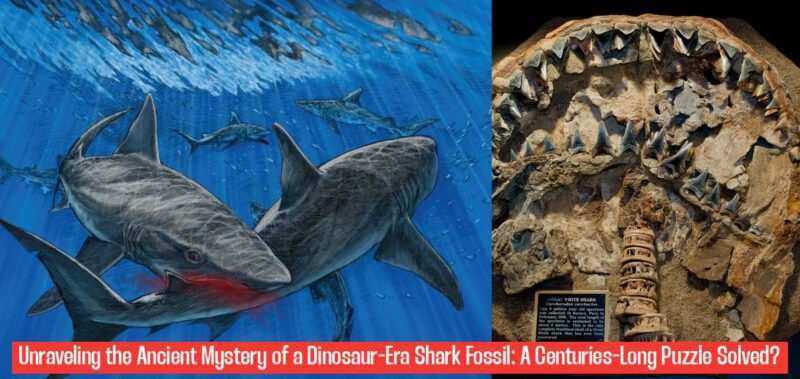Fossil of an ancient shark that swam in the age of dinosaurs solves centuries-long mystery
For centuries, the world of paleontology has been captivated by the enigmatic remains of ancient sharks, particularly those that roamed the oceans alongside dinosaurs. These prehistoric predators, with their fearsome teeth and imposing size, have left behind a trail of clues that have puzzled scientists for generations. But now, a groundbreaking discovery has shed light on one of the most enduring mysteries, revealing crucial details about a long-lost shark lineage and its connection to a modern-day apex predator.
Unveiling the Secrets of Ptychodus: A Prehistoric Shark Mystery Solved
The discovery of complete fossils from an enormous shark that lived alongside the dinosaurs has provided a crucial piece of the puzzle surrounding these enigmatic creatures. These sharks, belonging to the genus Ptychodus, have been a source of scientific intrigue since their initial discovery in the mid-eighteenth century. For decades, paleontologists have been grappling with the question of how these prehistoric giants hunted and what their evolutionary relationships were.
The newly discovered fossils have revealed that Ptychodus sharks were not just massive in size, reaching lengths of over 30 feet, but also possessed a unique set of adaptations that set them apart from other ancient sharks. Their powerful jaws were armed with rows upon rows of flattened, pavement-like teeth, perfectly suited for crushing the shells of their prey. These teeth, unlike those of modern sharks, were not designed for tearing flesh but for grinding hard-shelled creatures like mollusks and crustaceans.
The discovery of complete skeletons has provided invaluable insights into the anatomy and physiology of Ptychodus. Scientists have been able to examine their skeletal structure, the arrangement of their fins, and the shape of their bodies, providing a more complete picture of their swimming abilities and hunting strategies.
A Link to the Great White: Unraveling the Evolutionary History of *Ptychodus*
One of the most intriguing findings of this discovery is the revelation that Ptychodus sharks were ancient relatives of the great white shark, the apex predator of modern oceans. This connection was established through careful analysis of the newly unearthed fossils, which revealed similarities in skeletal features and tooth structure between Ptychodus and modern-day white sharks.
This discovery has significant implications for our understanding of shark evolution. It suggests that the lineage leading to the great white shark has a much deeper history than previously thought, dating back to the age of dinosaurs. By tracing the evolutionary journey of Ptychodus, scientists can gain a deeper understanding of how these sharks adapted to changing environments and evolved into the magnificent creatures we know today.
The Significance of Complete Fossils: A New Era in Shark Paleontology
The discovery of complete Ptychodus fossils marks a significant milestone in the field of shark paleontology. For years, scientists have relied primarily on isolated teeth and fragments of jaws to reconstruct the anatomy and behavior of these ancient creatures. However, the newfound complete skeletons provide a wealth of information that was previously unavailable.
The completeness of these fossils allows scientists to study the entire skeleton, including the fins, vertebrae, and ribs, providing a comprehensive picture of their anatomy, swimming abilities, and overall body plan. This level of detail is crucial for understanding their adaptations, hunting strategies, and evolutionary relationships.
The Lasting Legacy of *Ptychodus*: A Prehistoric Giant with a Powerful Bite
The Ptychodus shark, with its massive size and powerful jaws, was a true giant of the prehistoric seas. This ancient predator ruled the oceans during the Cretaceous period, a time when dinosaurs roamed the land. Their presence in the fossil record provides a glimpse into the diverse and fascinating world of ancient marine life.
The discovery of complete Ptychodus fossils has not only solved a long-standing mystery but has also opened up new avenues of research in shark paleontology. By studying these magnificent creatures, scientists can gain a deeper understanding of their evolutionary history, their role in the marine ecosystem, and the remarkable adaptations that allowed them to thrive in a world vastly different from our own.
The Evolutionary Journey of Sharks: From Ancient Predators to Modern Apex Predators
The story of Ptychodus is just one piece of the larger puzzle of shark evolution. Over millions of years, sharks have evolved into a diverse array of species, each adapted to its own niche in the marine environment. From the diminutive dwarf lanternshark to the colossal whale shark, sharks exhibit an incredible diversity of form and function.
The evolutionary history of sharks is a testament to their resilience and adaptability. They have survived multiple mass extinction events, adapting to changing environments and exploiting new ecological niches. Their success can be attributed to a combination of factors, including their streamlined bodies, powerful jaws, and keen senses.
The Importance of Shark Conservation: Protecting Our Ancient Legacy
Sharks are not just remnants of a bygone era; they are vital components of modern marine ecosystems. Their role as apex predators helps to maintain the balance of the food web, keeping populations of prey species in check. However, many shark species are facing threats from overfishing, habitat loss, and climate change.
Efforts to conserve sharks are crucial for preserving the health of our oceans and ensuring the survival of these ancient creatures. By understanding their biology, ecology, and evolutionary history, we can better appreciate their importance and take steps to protect them for future generations.
The Enduring Mystery of Ancient Sharks: A Journey of Discovery Continues
While the discovery of complete Ptychodus fossils has provided crucial insights into the anatomy and evolution of this ancient shark, there are still many mysteries to be unraveled. The world of shark paleontology is a rich tapestry of discovery, with new fossils and insights emerging regularly.
The journey to understand these ancient creatures continues, driven by the tireless efforts of paleontologists who seek to uncover the secrets hidden within the rocks. With each new discovery, we gain a deeper appreciation for the incredible diversity and resilience of life on Earth.
What is the significance of the discovery of the ancient shark fossil?
The discovery of the ancient shark fossil has solved a centuries-long mystery in paleontology, shedding light on the lineage and evolutionary connections of these prehistoric creatures.
What sets Ptychodus sharks apart from other ancient sharks?
Ptychodus sharks were massive in size, reaching over 30 feet in length, and had unique flattened, pavement-like teeth designed for crushing hard-shelled prey like mollusks and crustaceans.
How have complete fossils helped scientists understand Ptychodus sharks better?
Complete fossils have provided insights into the anatomy, physiology, swimming abilities, and hunting strategies of Ptychodus sharks, allowing scientists to paint a more detailed picture of these ancient predators.
What connection was established between Ptychodus sharks and modern-day apex predators?
Through careful analysis of the fossils, scientists have revealed that Ptychodus sharks were ancient relatives of the great white shark, the apex predator of modern oceans, unraveling their evolutionary history.


